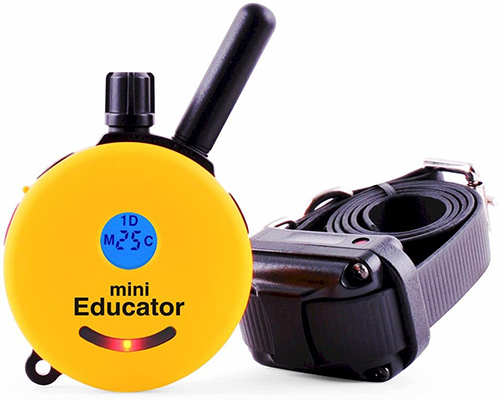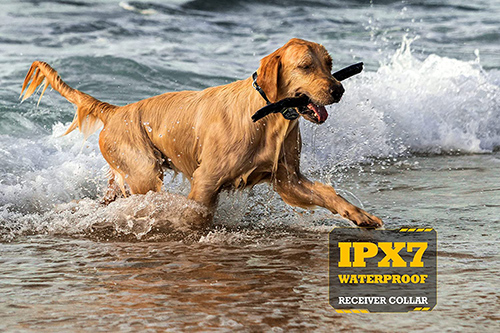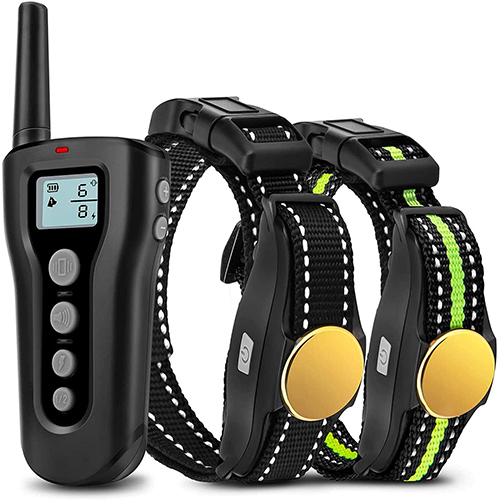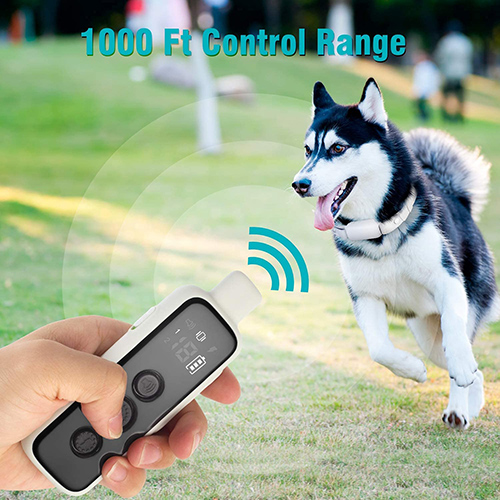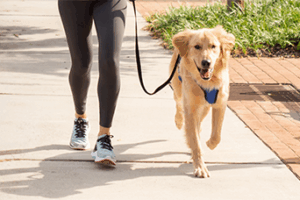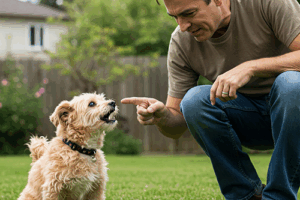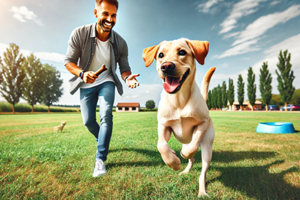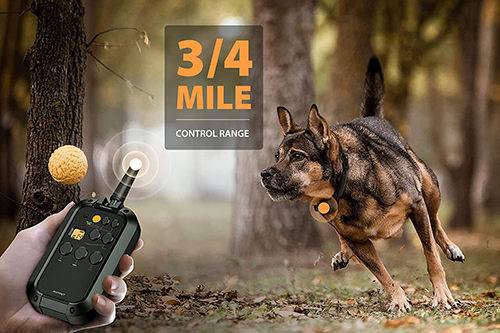
Before considering an e-collar for dogs, you need to know what you are training for. Are you going to train at home for hunting or control their barking? The type of e-collar you get depends on your training goals. Also, you will need to know the size of your dog because not all e-collars are a good fit for smaller breeds such as the Shih Tzu.
Choosing the Best E Collar for Dogs
One of the most challenging decisions you will have to make when training is what e-collar to purchase for your dog. This list of e-collars should give you some ideas depending on your training goals. For instance, if you want to housetrain, you will want to get e-collars specifically for yard training.
Top Five Tips to Choosing E Collars for Dogs
If you do not know which e-collar to purchase, here are five tips to help you make an informed and intelligent decision:
- Get an e-collar you can depend on, do not buy any collar that you can find. The cheapest e-collar is not always the best. Get an e-collar that has excellent reviews and one that is waterproof. Take your time and do your research. Read as many online reviews on the product as possible. Compare and contrast the reviews with a variety of e-collars. This tip will allow you to narrow your choices a little more.
- Education is the main factor in choosing the right product. Most of the e-collars on the market will come with instructions as well as training videos. Always concentrate on e-collars that show they’re meant to train your dog and not punish your dog. However, e-collars for dogs are not a shortcut for training; it is a training method that helps your dog understand that certain behaviors will not be tolerated.
- Understand what your options are when it comes to e-collars for dogs. Perform as much research as necessary to fully understand this highly effective training tool. Therefore, get educated on your dog’s breed and how they handle training. Your canine companion’s age will also affect how they handle training. Also, understand that some breeds are known for their stubborn characteristics and will require a longer training time. Therefore, when stubborn dogs give you a hard time, do not give up; stay the course, and you and your dog will be satisfied with a better dog and dog parent relationship. Look for an e-collar with constant and nick options that easily allows you to switch between both settings.
- Choose e-collar for dogs that you fully understand. Some e-collars are more complicated than others. Do not choose an e-collar that will frustrate you; pick one that does not have plenty of buttons to press. By the time you locate the right button, the teaching moment would have passed, and your dog would not understand which action brought about the shock. Another great tip is to get a transmitter that you can fit in your pocket or attach to your belt for quick access.
- Choose a collar that only your dog can activate. Some e-collars can be activated by other dogs, especially if you’re utilizing a no-bark collar. Your dog will become confused if they receive any shock that was not meant for them. Your dog will not understand why it happened, especially if they are lying down or sleeping. The best e-collar for dogs are the ones that only set off a shock if it comes from the dog wearing the collar.
Your Dog’s Reaction to The E-Collar
I want to take some time to explain your dog’s reaction to the e-collar fully. Firstly, understand that an e-collar can distress your dog; this is always a possibility even before your dog experiences a shock for the first time. One of the best tips for knowing how your canine companion will react to the e-collar is understanding them before purchasing the collar.
For instance, if you rescue your dog from a shelter and he isn’t very friendly, then the possibility of your dog being skittish around the e-collar increases. This problem will not help the training sessions, especially when they are shocked. Another great way to know how your canine family member will react is to place another collar on them, which is a good idea for dogs that have never worn a collar.
You will have the opportunity to observe how your dog reacts to wearing a regular collar, which will give you an understanding of if you will need to seek professional help from a trainer for the best way to introduce and get your dog to accept wearing an e-collar.
Unintended Reactions to Wearing an E-Collar
There is always a good chance your dog will react to the e-collar in a way you didn’t see coming. This reaction usually occurs when they experience their first shock or throughout their training. You may think you’re training them not to stray out of the yard when you’re training them to be afraid of people.
For instance, let us look at a few examples to better understand what I mean by unintended reactions.
Example #1: Casey is a one-year-old Shih Tzu dog that loves to run over to the neighbor’s yard whenever he sees them outside. Although this would typically not be an issue with Casey’s owners. However, safety is an issue because the neighbor’s yard is across the street. Thankfully, the neighbor is always kind enough to walk Casey back home, and there is the danger of Casey getting hit by a car whenever he sees the neighbors and runs across the street.
This occurrence is the only time Casey feels compelled to run into the street. He’s usually a good dog and stays in the yard. Therefore, his owners were not entirely sold on an e-collar to train Casey not to run into the street. However, they decided it was the best option to keep their beloved canine family member safe.
Whenever they bring Casey outside, they place the e-collar on him, and as accustomed, Casey would dash to the neighbor’s yard when they came out, and he would experience the mild shock of the e-collar. One day, the neighbor came over, and when Casey saw him come through the door, he ran over and nipped him on the leg. Of course, the neighbor and Casey’s owners were dumbfounded by the dog’s actions.
Why did he bite the neighbor? They knew he loved going to visit them, so what changed? After explaining the situation to a professional dog trainer, it was clear that Casey did not associate the road to the shock. Instead, he associated the neighbor with the shock. This occurred because Casey wanted to see the neighbor when he experienced the shock. The street was the last thing on the dog’s mind, or that this was the reason for the shocks from the collar.
Example #2: Katie’s parents gave her a six-month-old puppy named Abner for her 11th birthday. The family loved and adored Abner, but Katie’s mother always worried when Katy would take Abner out on walks. Though she always accompanied them on the walks, Katie always held Abner’s leash. Abner is a very energetic puppy and usually pulls Katie when he sees another dog.
After conversing with her husband, Katie’s parents decided on getting an e-collar for Abner. While walking, Katie’s mom would shock Abner every time he started to pull away. At first, it seemed like it worked well until Abner began showing signs of being anxious and aggressive whenever he saw another dog.
One day when walking Abner, Katie and her mom noticed the neighbors walking their dog and started to walk toward their friends. However, Abner stopped and refused to get any closer. The neighbors didn’t think anything of it because Abner was a puppy and was seen as being a little difficult. So, they continued their approach toward Katie, her mom, and Abner.
The closer they got, the more Abner tried to escape the situation. Katie and her mom could not understand why Abner was behaving in this manner. After a few more times of this behavior, the family explained the situation to a trainer. According to the trainer, Abner was not associating the shock with pulling Katie; he was associating other dogs with the shock.
Dogs are not mind readers and do not understand the goals we have for them, as these examples show. Both dogs would have received more effective training without the shock collars. Casey didn’t run out into the street unless he saw the neighbors; therefore, his owners could have used positive reinforcement to get him to stay on the sidewalk and wait for the neighbor to come over.
The same goes for Abner. Positive reinforcement to not pull Katie when another dog comes into view would have worked better.
Always take the time to think about your dog’s goals when participating in behavior that is not wanted. If they are trying to meet another dog or person, it is best not to shock them because they will associate their mission with the shock.
What if your Dog is Fearful of The E-Collar
One of the challenges of an e-collar for dogs is that your canine companion may be afraid of the collar. This fear can manifest itself due to two main reasons.
- First, the dog may exhibit anxiety and fear of any collar going around its neck. This can result from past experiences, or your dog is not that trusting and more fearful than other dogs. Depending on the reason will depend on how you remedy the situation. For instance, a naturally more fearful dog will overcome that fear much easier than a dog with negative past experiences with a collar.
Using e-collar for dogs that are scared of them has sparked many debates. Many people believe that you should never use an e-collar on a dog that exhibits fear because their fear will increase. Other people think that this is one of the many myths about e-collars for dogs, and if the dog is trained the right way, you don’t have to worry about that fear.
It would be best if you ascertained where the fear came from. If the dog is scared of the collar, you want them to get comfortable with a different collar and build up toward the e-collar. Even if you decide to leave the e-collar for dogs for one or two weeks without sending a shock, you need to start with a regular collar. - Second, Introduce the regular collar slowly. For example, allow them to smell the collar and then put it aside. Later, reintroduce the collar and set it down beside them. Watch your dog’s reaction closely because if they exhibit fear, take the collar away. Go slowly until you can place the collar around the dog’s neck without them trying to escape from it.
Once they get to the point they can wear the collar for a week or two without trying to rip it off, you can then attempt to put on the e-collar for dogs. You might have to take it a bit slower when introducing the e-collar for dogs because it is different from the first one, but things will settle down and go smoothly after a while.
There is a slim probability that your dog may never be comfortable with an e-collar for dogs. If your canine family member is from a rescue, a pet store, or a shelter, they may have horrible memories of collars. This trauma is something that they may never get over, just like any trauma human beings can face.
Take into account that there are other ways to train your canine companion without an e-collar for dogs. Your dog’s mental stability and health are more important than any training. Some dogs are okay whenever you put an e-collar on them, and they get accustomed to the collar. However, once you begin to shock them once or twice, they get scared.
For example, Stetson is a Basset Hound learning how to hunt. His owner introduced an e-collar on him about two weeks ago and has utilized it two times to get Stetson to come back once he has found the bird.
One day Stetson’s owner tones him that the shock is about to happen if he does not come back. Instead of heading back, Stetson drops to the ground and doesn’t move. Stetson’s owner goes up to him and notices that the dog is terrified. Stetson looks up at his owner and lets out a whimper.
A week later, Stetson and his owner are at a training class. His owner explained what happened and wanted to know how to deal with the situation. The trainer knew immediately that Stetson was terrified of the shock and that this is an everyday occurrence with some dogs.
The dogs understand that a tone means a shock is coming, and they freeze because they do not want to get shocked and do not know how to protect themselves from it. Basset Hounds are not the easiest to train with an e-collar for dogs. The reason is that many tend to freeze out of fear.
We can elaborate on other training methods other than an e-collar for dogs. Remember that it is best not to use an e-collar for dogs unless necessary. Your dog can exhibit a plethora of reactions toward an e-collar. Some are known to become more aggressive when shocked.
If your dog’s reaction is fear or aggression, halt using the e-collar for dogs immediately. Those dogs tend to respond better to a rewards system and leash training. I recommend putting your dog into some training classes and learning other training techniques with a professional.
Hattie and Her E-Collar
Hattie is a black Flat-Coated Retriever who was taken in by owners Peggy and Hector because she didn’t have what it takes to be a show dog. She was born furless, and while her first owners took her to the vet and gave her the proper medicine, her fur refused to grow on the tip of her nose.
Hector, who worked with Hattie’s original owners, discovered that they would send her to the shelter because they only raise show dogs, train them and then sell them. Hector stepped in and agreed to purchase Hattie for his wife.
When Hector brought Hattie home, she was only seven months old. Hector and Peggy read up on how to raise a Flat-Coated Retriever because they knew these dogs had natural hunting instincts, but the couple was not hunters.
Therefore, Hector and Peggy started the basic training with Hattie, but she had a bad habit of chewing on shoes. She would steal shoes from all over the home and chew them until they were damaged. It was almost impossible to get her away from the shoe whenever Hector and Peggy would catch her in the act.
The couple was worried about the dog’s safety because of the possibility of her swallowing a shoestring, leather, or rubber. Finally, fed up with all the damaged shoes and worrying about the dog’s health, they investigated other training methods.
After plenty of research and questions, the couple decided to try an e-collar for dogs. Peggy worked from home; therefore, she spent her days training Hattie and following the e-collar instructions. She allowed Hattie to wear the collar for an entire week before she started to shock her.
On the day that Peggy decided to start using the collar, Hattie had a shoe in her sight and decided to pounce. As soon as Hattie placed her mouth on the shoe, Peggy gave the warning and then a shock. Hattie got a little startled but continued after the shoe.
Somewhat reluctantly, because Peggy did not want to hurt her canine family member, she gave the dog a second warning and then a shock. This time, Hattie barely budged. Peggy wrestled the shoes away from Hattie by coaxing her with a doggy snack.
Peggy then adjusted the settings on the e-collar for dogs to a higher shock level, but not too much more. Later that same day, Hattie was at it again. She went straight for a pair of shoes, and Peggy gave another warning and then a shock, which caused Hattie to jump back from the shoes.
When Hector came home, she told him about all that had happened. The couple immediately got in touch with some friends who also used an e-collar for dogs and conversed with them. They worried that the shock level might have been too strong for Hattie. The friend told the couple that they should lower it since the dog reacted to the first shock level.
Hattie will need the warning and shock before she touches the shoe. She wouldn’t get frightened or aggressive whenever she saw a shoe. Once the dog starts chewing on the shoe, she is so interested in chewing that she hardly recognizes the shock. Flat-Coated Retrievers are hunting dogs and are very determined.
It is challenging to remove them from anything they set their sights on. Peggy followed the friend’s advice, and it helped immensely. Within two weeks, whenever Hattie saw a nice juicy shoe, she would hesitate. The moment she hesitated, Peggy watched her body movements closely; if Hattie took another step closer to the shoe, she gave the warning.
If Hattie walked away like a good girl, nothing would happen. The dog would not hear the warning sound. Training went so well that it got to the point the couple could leave their shoes in front of the door as they usually did before they got Hattie. The e-collar training was an absolute success.

